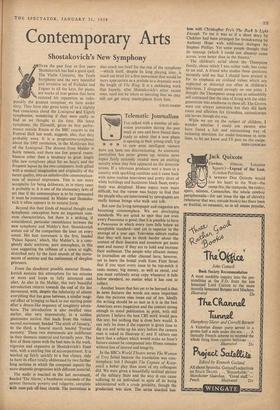Contemporary Arts
Shostakovich's New Symphony
OVER the past four or five years Shostakovich has had a good spell. The Violin Concerto, the Tenth Symphony and the very beautiful and inventive set of Preludes and
Fugues in all the keys, for piano, are works of true genius that have
restored his reputation as indis- putably the greatest composer, we have under sixty. They have also given Some of us a slightly bad conscience about the Leningrad and Eighth symphonies, wondering if they were really so bad as we thought at the time. His latest symphony, the Eleventh, given its first perfor- mance outside Russia at the BBC concert in the Festival Hall last week, suggests, alas, that they probably were. It is a programme-symphony about the 1905 revolution, in the Mahlerian line of the Leningrad. The descent from Mahler is fairly remote, and there are few general resem- blances other than a tendency to great length (the new symphony plays for an hour), and the frequent lapses by the two composers, both gifted with a musical imagination and originality of the rarest quality, into an unbelievable commonplace- ness of musical expression. This is not more acceptable for being deliberate, as in many cases it probably is. It is one of the elementary laws of art that if the commonplace is to be represented it must be transmuted. In Mahler and Shostako- vich it often appears in its natural form.
Beyond this their kinds of musical thought and symphonic conception have no important com- mon characteristics, but there is a striking, if coincidental, particular resemblance between the new symphony and Mahler's first. Shostakovich comes out of the comparison the loser on every count. His best movement is the first, headed 'Palace Square,' which, like Mahler's, is a com- pletely static nocturne, pure atmosphere, in this case suggesting the stillness of a town at night, disturbed only by the faint sounds of the move- ments of sentries and the restlessness of sleepless prisoners.
From the slenderest possible material Shosta- kovich sustains this atmosphere for ten minutes or more and keeps us fully interested and alert. As also in the Mahler, this very beautiful introduction returns towards the end of the last movement, with, despite the inferiority of almost everything that has gone between, a similar magi- cal effect of bringing us back to our starting point after a dream-like sequence of imaginary adven- tures. The introduction is also recalled once earlier, also very impressively, in a sudden pianissimo section that leads from the violent second movement, headed 'The ninth of January,' to the third, a funeral march headed 'Eternal memory.' These two movements are indifferent in their thematic material and formally poor. The first of them opens with the best tune in the work, vigorous and expansive in Shostakovich's finest vein, with a swirling line of accompaniment. It is worked up fairly quickly to a fine climax, only to have its effect totally obliterated by two further long sections in which the composer repeats the same dramatic progression with different material.
The nadir is reached in the last movement, headed 'The Alarm,' a bombastic crescendo of the utmost thematic poverty and vulgarity, complete with oom-pah off-beat chords. The movement is
also much too brief for the rest of the symphony —which itself, despite its long playing time, is much too brief for a first movement that would be more appropriate as a prelude to a dramatic work the length of The Ring. It is a saddening work that happily, after Shostakovich's other recent ones, need not be taken as meaning that we may still not get many masterpieces from him.
COLIN MASON






































 Previous page
Previous page